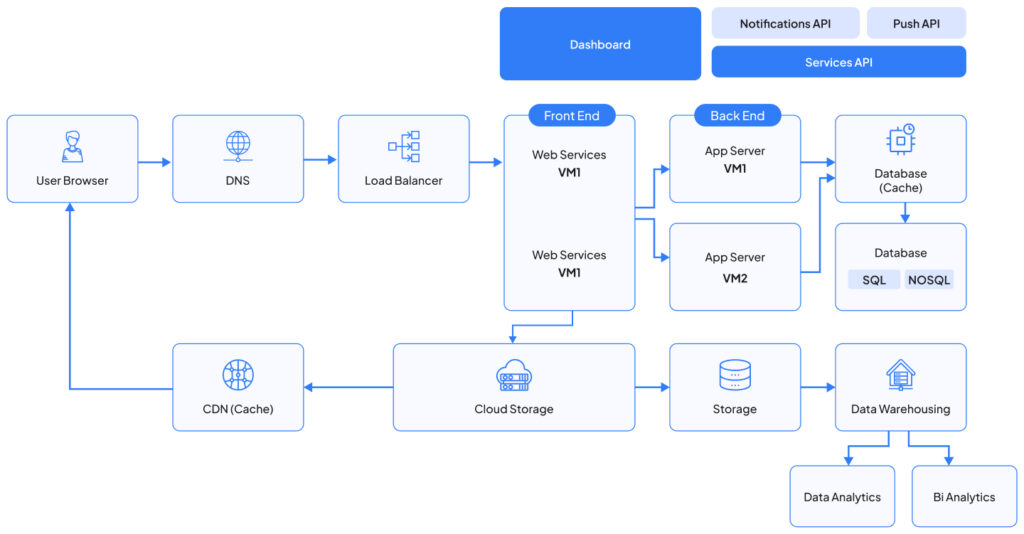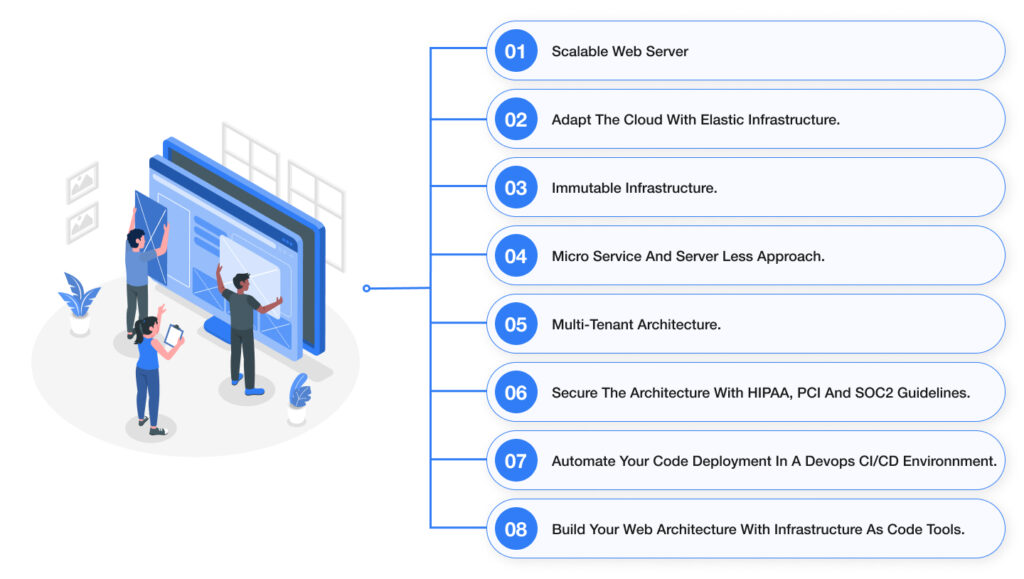The article on “Web Application Architecture Guide: Best Practices, Trends 2024” offers a comprehensive insight into the cutting-edge approaches, architectural concepts, and industry trends that will shape web application development in 2024. This guide equips you with the knowledge and strategies needed to build robust, scalable, and secure web applications that meet the demands of the modern digital world.
What is web application architecture?
The flowchart shares a pattern of information flow from user to database using different components and services related to web application architecture. While it lacks details, we can give a general overview of what a web application architecture might look like based on these components:
1. User Browser: This is where the end-users interact with your web application.
2. DNS: The Domain Name System (DNS) is responsible for translating domain names (e.g., www.example.com) into IP addresses.
3. CDN (Cache): A Content Delivery Network (CDN) is used to distribute content globally, improving the speed and reliability of content delivery.
4. Load Balancer: Load balancers distribute incoming network traffic across multiple servers to ensure high availability and reliability.
5. Dashboard: This may refer to an administrative dashboard used for monitoring and managing various aspects of the application.
6. Web Services VM1 and VM2: Virtual Machines hosting web services that interact with the web application.
7. Cloud Storage: Cloud-based storage solutions for data and assets.
8. DevOps & Software Development: This likely includes processes and tools for software development, deployment, and operations.
9. Notifications API: An API for sending notifications to users or other systems.
10. Services API: An API that allows different application components to communicate and share data.
11. App Server VM1 and VM2: Virtual Machines hosting application servers that run the core logic of the web application.
12. Storage: General storage, possibly used for file storage or asset management.
13. Database (Cache): A database with caching functionality to improve data retrieval speed.
14. Database: A primary database for storing application data.
15. SQL and NoSQL: Different database types, possibly used for structured and unstructured data.
16. Data Warehousing: A system for collecting and managing data from various sources for analytical purposes.
17. Data Analytics: Tools and processes for analyzing data.
18. BI Analytics: Business Intelligence (BI) tools for generating insights from data.
In a typical web application architecture, the user’s browser interacts with the application through various components like the load balancer and web servers. The application may use databases to store and retrieve data and caching mechanisms (like the “Database (Cache)”) to enhance performance. Additionally, CDNs can be used to deliver static content quickly, and APIs enable communication between different parts of the application.

Embrace DevOps Excellence Now!
Elevate Your Software Delivery and Operations with Folio3’s DevOps Solutions.
Get started todayReady to supercharge your DevOps with Generative AI? Explore our blog for insights and discover how Folio3 can help you optimize your development and operations. Dive into the possibilities now!
You should note that the actual architecture can be much more complex and may vary depending on the specific requirements of the web application.

Caption: This application architecture diagram explains in detail about the web architecture user journey
Exploring DevOps transformation? Dive deeper into our blog to uncover valuable insights, best practices, and solutions.
Web Application Architecture Best Practices
Web Application Architecture Best Practices offers guidelines for creating robust, scalable, and secure web applications. These practices include optimizing web servers for high performance, leveraging elastic cloud infrastructure for scalability, adopting immutable infrastructure for reliability, and implementing microservices and serverless architectures for agility.

Scalable, High-Performance Web Servers
Having scalable and high-performance web servers is paramount to the success of any web server architecture. These servers are the backbone of your application, ensuring that it can handle increasing loads without sacrificing speed and responsiveness. By implementing efficient load balancing and caching mechanisms, you can distribute incoming traffic across multiple web servers, achieving both reliability and performance. High-quality web servers are not only scalable but also optimize content delivery, guaranteeing a seamless user experience.
Enabling Cloud Scalability with Elastic Infrastructure
The cloud provides a dynamic environment for web applications. The elastic infrastructure allows you to adapt to changing workloads effortlessly. It ensures your application can scale up or down as needed, optimizing resource utilization and cost-efficiency. By harnessing the flexibility of the cloud, you can meet user demand efficiently while maintaining excellent performance.
Implementing Reliable Systems with Immutable Infrastructure
Immutable infrastructure is a game-changer for web application reliability. By creating and deploying servers in a fixed state and replacing them when updates are needed, you minimize the risk of configuration errors and improve consistency. This approach leads to more dependable systems, simplifies updates, and enhances the overall stability of your architecture.
Adopting Microservices and Serverless Architectures
Microservices and serverless architectures are revolutionizing the way web applications are built and deployed. By breaking down your application into smaller, independent components (microservices) or using serverless functions, you gain agility, scalability, and cost savings. These architectures empower developers to focus on specific functions, leading to faster development and easier maintenance.
Case Studies
Growth. Enabled.

Sunburst Type To Learn

InGenius Prep

Magento Cloud Migration

Nutrition Detection App
Multi-tenant Architecture
In multi-tenant architecture, multiple clients or tenants share the same application, but their data and configurations remain isolated. This approach is cost-effective and efficient, making it an excellent choice for software-as-a-service (SaaS) providers. The multi-tenant architecture ensures that different users can access the application without interference while minimizing operational overhead.
Building Secure Architectures: Complying with HIPAA, PCI, and SOC 2
Security is a top priority in web application architecture. Compliance with industry standards like HIPAA, PCI DSS, and SOC 2 is essential for handling sensitive data. Secure architectures involve robust access controls, data encryption, regular security audits, and adherence to compliance regulations. Building with security in mind is not only a best practice but also a legal and ethical requirement.
Automating Code Deployments with CI/CD Pipelines
Continuous Integration and Continuous Deployment (CI/CD) pipelines are essential for streamlining software development and deployment. These pipelines automate the building, testing, and deployment of code, reducing human errors and speeding up the release process. CI/CD practices promote a faster time to market, improve code quality, and enhance collaboration between development and operations teams.
Implementing Infrastructure as Code for Web Architectures
Infrastructure as Code (IaC) is a foundational practice for modern web application architecture. It enables you to define and manage infrastructure using code, making provisioning and configuration repeatable and reliable. With IaC, you can version, test, and deploy infrastructure changes with confidence, leading to more efficient development, reduced risk, and better collaboration between developers and operations teams.
Web Application Architecture Trends
Web application architecture is in a constant state of evolution. It adapts to address the changing landscape of modern applications. These trends include scalability, security, user experience, and architectural paradigms such as microservices and serverless computing. They influence the design, deployment, and maintenance of web applications, shaping a complex and dynamic architectural landscape.
Caching System (Caching System Design + Caching Tools)
Caching is a fundamental aspect of web application architecture, significantly impacting performance optimization. Page caching and object caching represent integral components of the caching system design. Caching tools such as Redis, Memcached, and Varnish are employed to execute these caching strategies. These tools effectively enhance speed and efficiency in content delivery and resource utilization within web applications.
Cloud Storage
Cloud storage services, exemplified by Amazon S3, Google Cloud Storage, and Azure Blob Storage, play a pivotal role in modern web applications. They provide scalable and cost-effective solutions for data storage, file hosting, and content delivery. Cloud storage is extensively employed across diverse industries and use cases, offering flexibility and accessibility to meet the growing demands of web architecture.
CDN (Content Delivery Network)
Content Delivery Networks (CDNs) are integral to web application performance. They minimize latency and optimize content delivery globally. CDNs operate through effective caching, reducing the load on origin servers. Their strategic presence at multiple points worldwide ensures efficient content distribution, ultimately enhancing the user experience by delivering web content swiftly and securely.
Load Balancer
Load balancers are a critical component of web application architecture, ensuring even traffic distribution among multiple servers. They come in various forms, including hardware and software load balancers. These devices utilize load-balancing algorithms, such as Round Robin and Least Connections, to manage incoming requests. They enhance fault tolerance, scalability, and resource utilization in web applications.
Multiple Servers
The use of multiple servers is a fundamental strategy for handling increased web traffic and maintaining system resilience. It encompasses server clustering, redundancy, and the concept of server farms or data centers. Multiple servers enhance performance, mitigate downtime, and efficiently distribute the workload to meet the demands of modern web applications.
Message Queues
Message queues, exemplified by RabbitMQ and Apache Kafka, facilitate asynchronous communication within web applications. They decouple components, allowing tasks to be executed independently and asynchronously. This architecture is invaluable for handling background tasks, ensuring data consistency, and building responsive, scalable web applications. Message queues are indispensable in scenarios where tasks need to be managed efficiently and reliably.
Learn how Folio3 can help you implement the right monitoring solution for your DevOps operations.
Types of Web Application Architectures
Web application architectures come in various forms, each with its own set of characteristics and advantages. In this section, we’ll explore different types of web application architectures and discuss their key features and use cases.
Monolithic Architecture
Monolithic architecture is a traditional approach where all components of a web application are tightly integrated into a single, large codebase. It’s known for its simplicity and ease of development but can become challenging to scale and maintain as the application grows. In a monolithic architecture, all functionalities, such as the user interface, database, and business logic, are bundled together within a single application.
Microservices Architecture
Microservices architecture is a modern approach where an application is broken down into small, loosely-coupled services, each responsible for specific functions. This architecture offers scalability and flexibility, allowing for the independent development, deployment, and scaling of individual services. Microservices are known for their resilience and ability to handle complex, distributed applications.
Read more about Microservices vs Monolith Architecture in our detailed blog.
Containers
Containers, exemplified by Docker, are lightweight, portable environments that package an application and its dependencies. They ensure consistency across different environments, making it easier to deploy and manage web applications. Containers have become a cornerstone of modern application development and are often used in microservices architectures.
Serverless Architecture
Serverless architecture, often associated with Function-as-a-service (FaaS) platforms like AWS Lambda, abstracts server management from developers. It allows them to focus solely on code development and execution. Serverless is highly scalable and cost-effective, as you pay only for the compute resources used during function execution.
AWS Lambda
AWS Lambda is a serverless compute service offered by Amazon Web Services. It allows developers to run code in response to events and automatically manages the computing resources required. AWS Lambda is commonly used for tasks such as data processing, real-time file manipulation, and event-driven microservices.

Ready to Revolutionize Your Development and Operations?
Discover the Future of DevOps with Folio3. Take the First Step to Empower Your Team and Accelerate Your Projects.
get started nowAPI Gateway
An API Gateway, such as AWS API Gateway, acts as a central entry point for managing and routing API requests. It offers features like authentication, rate limiting, and request/response transformation. API Gateways play a crucial role in exposing and managing the endpoints of microservices and serverless functions.
AWS Step Functions
AWS Step Functions provide serverless orchestration for coordinating multiple AWS services and serverless functions. They allow developers to define and execute workflows that involve multiple steps, ensuring that tasks are executed in a specified order. AWS Step Functions are particularly useful for building complex, stateful applications and managing long-running processes.
Interested in AWS DevOps consulting? Gain insights into AWS solutions and learn how Folio3 can help you navigate the world of AWS DevOps.
Conclusion
In this comprehensive guide on web application architecture, we’ve explored a wide range of best practices, trends, and architectural approaches that are set to shape the landscape in 2024.
We discussed the importance of understanding web application architecture, its key components, and the role they play in delivering seamless user experiences.
Additionally, we went in depth into the best practices, such as optimizing web servers, embracing elastic cloud infrastructure, and adopting microservices and serverless architectures.
We also highlighted multi-tenant architecture, secure architecture principles, and the significance of automating code deployments with CI/CD pipelines and Infrastructure as Code. Moreover, we dissected the latest trends, from caching systems to cloud storage, CDNs, load balancers, and message queues, as well as a diverse array of web application architectures. Whether you’re building, maintaining, or upgrading web applications, this guide equips you with the knowledge and strategies needed to succeed in an ever-evolving digital landscape.
FAQs
What are the three primary types of web architecture?
The three main types of web architecture are Monolithic Architecture, Microservices Architecture, and Serverless Architecture.
Which web architecture is considered the best choice for most web applications?
The most suitable web architecture depends on an application’s specific needs. However, Microservices Architecture is often preferred due to its flexibility and scalability, making it a strong choice for modern web applications.
What are the core components that constitute web application architecture?
Web application architecture comprises several essential components, including user browsers, DNS, CDNs for content delivery, load balancers, web services, application servers, cloud storage, databases, caching mechanisms, and APIs for inter-component communication, among others. The selection and configuration of these components depend on the specific requirements of the web application.

























